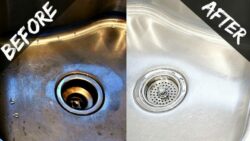Frozen water pipes can lead to severe water damage, costly repairs, and significant inconvenience. To mitigate this risk, it is imperative to take proactive measures to prevent frozen water pipes. This article explores a range of effective strategies that can help safeguard your pipes from freezing, including insulating vulnerable areas, sealing leaks, maintaining proper heating, and opening cabinet doors. By implementing these preventive measures, you will not only ensure uninterrupted water supply during winter but also protect your home from the detrimental consequences of frozen pipes.
Insulate Exposed Pipes
Insulating exposed pipes is crucial in preventing them from freezing during cold weather. There are several methods you can use to insulate your pipes effectively.
Use Insulating Sleeves or Foam
Insulating sleeves or foam are excellent options for protecting exposed pipes. These materials are designed to fit securely around the pipes, providing a layer of insulation that helps keep the pipes warm. Insulating sleeves or foam can be easily purchased from hardware stores and are typically easy to install.
Wrap Pipes with Pipe Insulation
Another effective method of insulating pipes is by wrapping them with pipe insulation. Pipe insulation comes in various materials, such as fiberglass or foam, and is available in different sizes to fit pipes of various diameters. By wrapping the pipes with insulation, you create a barrier that helps retain heat, preventing the pipes from freezing.
Insulate Outdoor Faucets
Outdoor faucets are particularly vulnerable to freezing temperatures. To protect them, you can insulate them using faucet covers or foam insulating tape. These insulating materials are designed to encapsulate the faucet, preventing cold air from reaching it and freezing the water inside. Insulating outdoor faucets is essential to prevent damage and potential leaks caused by frozen pipes.
Maintain Adequate Heating
Maintaining adequate heating within your home is crucial in preventing frozen water pipes. By following these steps, you can ensure that the temperature in your home remains at a level that prevents freezing.
Keep the Thermostat Set above 55°F (12°C)
It is essential to keep your thermostat set above 55°F (12°C) to maintain a warm enough temperature within your home. This will help prevent freezing of the water inside the pipes. Even if you are away from home, it is advisable to keep the temperature above freezing to avoid any potential damage.
Open Cabinet Doors to Allow Heat Circulation
In areas where pipes are located inside cabinets, such as under sinks, it is beneficial to keep the cabinet doors open. This allows the warm air from the room to circulate around the pipes, helping to keep them warm. By ensuring proper heat circulation, you can reduce the risk of freezing and potential pipe damage.
Use Space Heaters in Vulnerable Areas
If you have specific areas in your home that are particularly vulnerable to freezing, such as basements or crawl spaces, consider using space heaters. Space heaters can provide an additional source of heat to these areas, reducing the chances of pipes freezing. However, it is crucial to follow the manufacturer’s instructions and use space heaters safely to prevent any accidents or fire hazards.
Seal Air Leaks
Air leaks in your home can not only cause drafts but also allow cold air to penetrate and reach your pipes. By sealing air leaks, you can create a more energy-efficient and warmer environment, protecting your pipes from freezing.
Weatherstrip Doors and Windows
One effective method of sealing air leaks is by applying weatherstripping to doors and windows. Weatherstripping comes in various materials, such as adhesive-backed foam or V-strip weatherstripping, and can be easily installed. By sealing the gaps around doors and windows, you can prevent cold air from infiltrating your home, helping to maintain a warmer and more stable temperature.
Caulk Cracks and Gaps in Walls
Cracks and gaps in the walls of your home can also contribute to air leaks. Inspect your walls for any visible cracks or gaps and use caulk to seal them. Apply caulk along the cracks and gaps, smoothing it out to create an airtight seal. This will not only help prevent cold air from entering your home but also improve its overall energy efficiency.
Insulate Crawl Spaces and Attics
Crawl spaces and attics are areas in your home that are often overlooked but can be significant sources of air leaks. Proper insulation of these spaces is crucial to prevent freeze-prone pipes. Insulate crawl spaces and attics using insulation materials such as fiberglass or spray foam. This will create a barrier that helps retain warmth within your home and reduce the risk of freezing pipes.
Let Faucets Drip
Allowing faucets to drip can be a simple yet effective method of preventing frozen water pipes. By following these steps, you can mitigate the risk of pipe damage during freezing temperatures.
Allow Cold Water to Trickle
During cold weather, allow a small amount of cold water to trickle from the faucet. The constant flow of water prevents the water inside the pipes from becoming stagnant and freezing. Aim for a slow, steady drip to ensure continuous water flow and minimize the chances of freezing.
Run Warm Water Periodically
In addition to allowing cold water to trickle, it is also helpful to periodically run warm water through the pipes. Running warm water helps raise the temperature within the pipes, reducing the risk of freezing. By following this practice, you can further protect your pipes from potential damage during freezing temperatures.
Drain Outdoor Water Sources
Outdoor water sources, such as garden hoses and sprinkler systems, are particularly susceptible to freezing. To prevent damage to these water sources and the connected pipes, it is essential to drain them properly.
Disconnect and Store Garden Hoses
Before the arrival of freezing temperatures, disconnect all garden hoses from outdoor faucets. Drain any remaining water from the hoses by straightening them and manually allowing the water to flow out. Once drained, store the garden hoses in a warm, dry location to prevent any residual water from freezing and damaging the hose or the connected faucet.
Drain Sprinkler Systems
If you have an underground sprinkler system, it is crucial to drain it properly before freezing temperatures. Consult the manufacturer’s instructions or seek professional assistance to ensure the correct procedure for draining your specific sprinkler system. By removing all the water from the sprinkler system, you reduce the risk of frozen pipes and potential damage.
Use Frost-Proof Spigots
Consider installing frost-proof spigots for your outdoor faucets. These spigots are designed to prevent freezing by directing water flow away from the vulnerable sections of the pipe. Frost-proof spigots enable you to shut off and drain the water supply from inside your home, further reducing the risk of frozen pipes and potential leaks.
Warm Pipes with Heat Tape
Heat tape is an effective solution for warming pipes that are susceptible to freezing. By following these steps, you can protect vulnerable pipes from freezing and potential damage.
Wrap Heat Tape Around Pipes
To use heat tape, start by wrapping it tightly around the exposed pipes. Heat tape is designed to provide a controlled amount of heat to keep the pipes warm. Ensure that the heat tape covers the entire length of the exposed pipe, leaving no gaps or areas exposed to freezing temperatures.
Plug in and Monitor Heat Tape
After securely wrapping the heat tape around the pipes, plug it into an electrical outlet. Most heat tape includes a built-in thermostat that regulates the temperature and only activates when necessary. Monitor the heat tape regularly to ensure that it is functioning correctly and that the pipes are warm. This method of warming pipes is particularly useful in areas where insulation alone may not be sufficient.
Keep Interior Doors Open
In colder climates, it is crucial to allow heat to circulate between rooms to prevent freezing of water pipes. By keeping interior doors open, you encourage the flow of warm air and help maintain a consistent temperature throughout your home.
Allow Heat to Circulate Between Rooms
Open interior doors allow heat to circulate freely between rooms, reducing the likelihood of cold spots and frozen pipes. This practice is particularly important for rooms that have plumbing fixtures, such as bathrooms and kitchens. By ensuring proper heat circulation, you minimize the risk of freezing and potential damage to your water pipes.
Shut Off Outdoor Water Sources
Shutting off outdoor water sources is a crucial step in preventing frozen water pipes. By following these steps, you can ensure that no water remains in the outdoor lines, minimizing the risk of freezing.
Close Outdoor Water Valves
Locate and close any outdoor water valves that supply water to your outdoor faucets or sprinkler systems. Closing these valves prevents water from flowing into the outdoor lines, reducing the risk of freezing.
Drain and Disconnect Outdoor Water Lines
After closing the outdoor water valves, drain any residual water from the outdoor lines. Disconnect any hoses or attachments connected to outdoor faucets and let the water flow out completely. Draining and disconnecting the outdoor water lines effectively removes any remaining water that could freeze and potentially damage the pipes.
Install a Leak Detection System
Installing a leak detection system can provide added protection and help identify any potential issues with your water pipes. There are different types of leak detection systems available, and utilizing them can help prevent significant damage caused by frozen or burst pipes.
Use Water Leak Detectors
Water leak detectors are devices designed to monitor the moisture levels in your home and provide an alert if water is detected. By placing these detectors near your water pipes or in areas prone to leakage, you can quickly identify any water-related issues and take prompt action to prevent further damage.
Install a Whole-House Leak Detection System
For comprehensive protection, consider installing a whole-house leak detection system. These systems utilize moisture sensors strategically placed throughout your home and can be connected to a central monitoring unit. A whole-house leak detection system can provide real-time alerts in the event of a leak or moisture buildup, allowing you to address the issue promptly and minimize potential damage.
Insulate Garage and Basement Walls
Insulating garage and basement walls is essential to protect pipes that are located in these areas. By insulating these walls, you create a thermal barrier that helps maintain a warmer temperature, reducing the risk of frozen water pipes.
Add Insulation to Garage Walls
Garages are typically unheated, making them susceptible to colder temperatures. To prevent freezing pipes in the garage, consider adding insulation to the garage walls. Use insulation materials such as fiberglass or foam board to create a barrier that helps retain heat and maintains a more stable temperature within the garage.
Insulate Basement Walls
Basements are another area where pipes are often located, and proper insulation is crucial to prevent freezing. Insulate basement walls using insulation materials suitable for below-grade applications, such as spray foam or rigid foam insulation boards. This will provide a layer of protection against frozen pipes and maintain a warmer environment within your basement.
In conclusion, preventing frozen water pipes is essential to avoid potential damage and costly repairs. By insulating exposed pipes, maintaining adequate heating, sealing air leaks, letting faucets drip, draining outdoor water sources, using heat tape, keeping interior doors open, shutting off outdoor water sources, installing a leak detection system, and insulating garage and basement walls, you can significantly reduce the risk of frozen pipes and ensure the uninterrupted flow of water during colder temperatures. It is important to be proactive and implement these measures before the arrival of cold weather to safeguard your water supply and prevent any inconveniences caused by frozen pipes.





